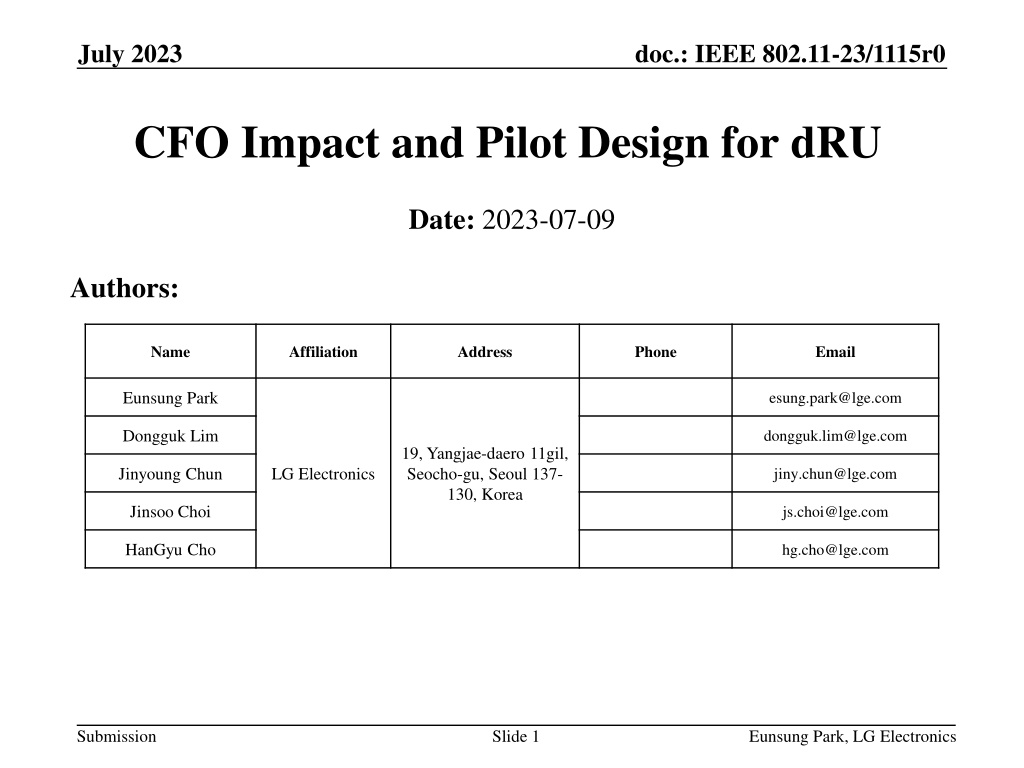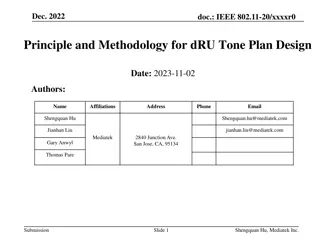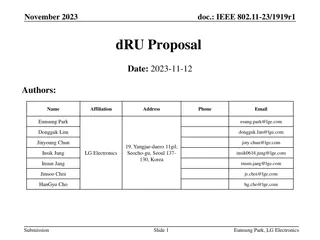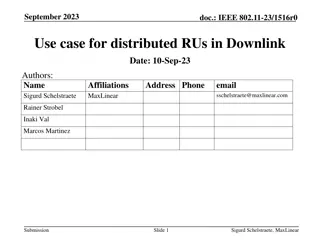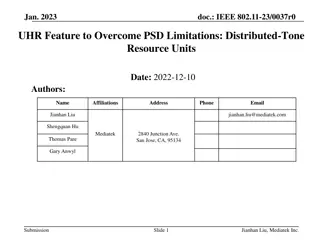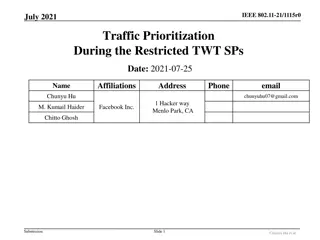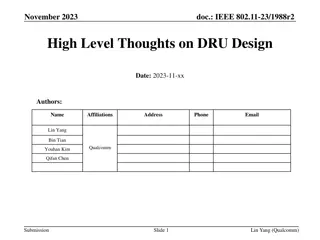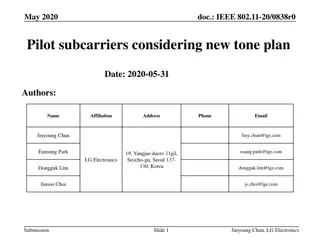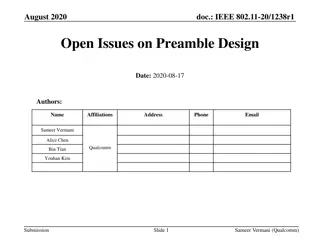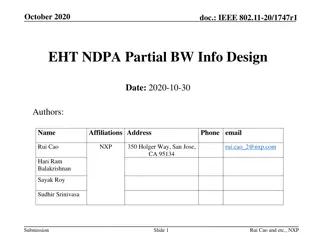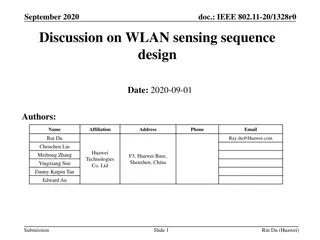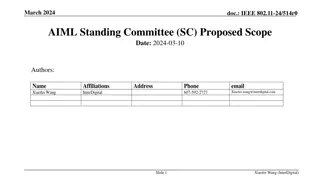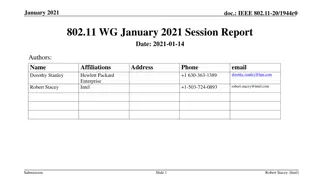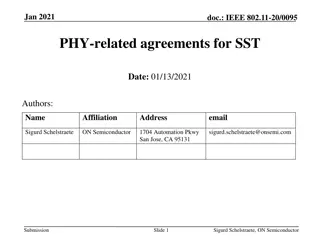IEEE 802.11-23/1115r0: Pilot Design Comparison for dRU Performance
Investigating pilot design methods for dRU performance in IEEE 802.11-23/1115r0 to overcome PSD limitations, comparing two pilot design options, exploring different residual CFO values, and assessing performance using various MCS levels and LDPC coding.
Download Presentation

Please find below an Image/Link to download the presentation.
The content on the website is provided AS IS for your information and personal use only. It may not be sold, licensed, or shared on other websites without obtaining consent from the author. Download presentation by click this link. If you encounter any issues during the download, it is possible that the publisher has removed the file from their server.
E N D
Presentation Transcript
July 2023 doc.: IEEE 802.11-23/1115r0 CFO Impact and Pilot Design for dRU Date: 2023-07-09 Authors: Name Affiliation Address Phone Email Eunsung Park esung.park@lge.com Dongguk Lim dongguk.lim@lge.com 19, Yangjae-daero 11gil, Seocho-gu, Seoul 137- 130, Korea Jinyoung Chun LG Electronics jiny.chun@lge.com Jinsoo Choi js.choi@lge.com HanGyu Cho hg.cho@lge.com Submission Slide 1 Eunsung Park, LG Electronics
July 2023 doc.: IEEE 802.11-23/1115r0 Introduction To overcome PSD limitations which are defined per 1 MHz, dRU was introduced in [1] We presented our view on dRU design ways for a tone plan, pilot and signaling in [2] In this contribution, we compare the pilot design methods introduced in [2] and investigate performance considering various values of residual CFO We also provide rRU performance as a baseline Submission Slide 2 Eunsung Park, LG Electronics
July 2023 doc.: IEEE 802.11-23/1115r0 Pilot Design (1/2) Option 1: define new pilot position In order to build a 26-tone dRU, 26 distributed tones are allocated and then two tones among them are selected as pilot tones E.g., the 7th and 20th tones in each 26-tone dRU can be determined as the pilot tones similar to the middle 26-tone rRU in 20 MHz Data tones Pilot tones 1st tone 6th tone 19th tone 20th tone 26th tone 7th tone For dRUs larger than 26, we can simply define data and pilot tones based on 26-tone dRUs or pilot tones can be changed for a better performance We are open and need further study Submission Slide 3 Eunsung Park, LG Electronics
July 2023 doc.: IEEE 802.11-23/1115r0 Pilot Design (2/2) Option 2: maintain conventional pilot position In order to build a 26-tone dRU, 24 distributed tones are allocated as data tones and then two tones among the conventional pilot tones are additionally allotted as pilot tones Pilot tones selected out of the conventional pilot tones Data tones 1st tone 6th tone 19th tone 20th tone 24th tone 7th tone One possible approach to select two pilot tones is considering the mapping rule between rRU and dRU as shown in [3], i.e., pilot tones for an rRU corresponding to a certain dRU can be allocated to the dRU as pilot tones For dRUs larger than 26, we can simply define data and pilot tones based on 26-tone dRUs and in this approach the conventional pilot position can be still maintained Submission Slide 4 Eunsung Park, LG Electronics
July 2023 doc.: IEEE 802.11-23/1115r0 Performance Comparison (1/3) We investigate PER performance for two options considering various residual CFO values Performance for rRU is also provided Assumptions 20 MHz UL TB PPDU with nine 26-tone dRUs / nine 26-tone rRUs SISO with Channel D NLoS 1000 data bits per each STA MCS 0/3/5/8 with LDPC coding Residual CFO for each STA: [+rCFO rCFO +rCFO rCFO ] Different rCFO values are considered depending on the MCS level Pilot position for dRU Option 1: 7th and 20th tones in each 26-tone dRU Option 2: pilot tones of x-th 26-tone rRU for x-th 26-tone dRU PERs for the first 26-tone dRU and first 26-tone rRU are provided Submission Slide 5 Eunsung Park, LG Electronics
July 2023 doc.: IEEE 802.11-23/1115r0 Performance Comparison (2/3) Simulation results MCS 3 MCS3 0 10 rRU w 0Hz rRU w 300Hz rRU w 500Hz Op1 dRU w 0Hz Op1 dRU w 300Hz Op1 dRU w 500Hz Op2 dRU w 0Hz Op2 dRU w 300Hz Op2 dRU w 500Hz PERs for MCS 0 / 5 / 8 are shown in Appendix and the trend is similar -1 PER 10 -2 10 2 4 6 8 10 12 14 SNR [dB] When there is no residual CFO (rCFO = 0 Hz), dRU provides a significant performance gain dRU has a wider performance gap between with and without a residual CFO dRU still outperforms rRU even though a certain residual CFO is present Option 1 offers better performance than option 2 when rCFO > 0 Hz Submission Slide 6 Eunsung Park, LG Electronics
July 2023 doc.: IEEE 802.11-23/1115r0 Performance Comparison (3/3) When there is no residual CFO, dRU achieves quite better performance than rRU, no matter what the pilot option is That is because dRU can obtain a significant frequency diversity gain As a residual CFO increases, dRU performance deteriorates much faster That is because dRU is more vulnerable to the residual CFO However, its performance is still better than that of rRU In addition, thanks to the higher transmit power for dRU, dRU performance can be further enhanced Option 1 provides better performance than option 2 That is because option 1 may produce more appropriate pilot position compared to the approach employed in option 2 Note that there is still a room to improve the performance for option 2, and we can come up with a better approach on how to select two pilot tones out of the conventional ones Slide 7 Submission Eunsung Park, LG Electronics
July 2023 doc.: IEEE 802.11-23/1115r0 Conclusion We have introduced two pilot options for dRU Option 1: define new pilot tone indices Option 2: maintain conventional pilot tone indices We have also shown various simulation results for both options comparing with rRU We have confirmed that dRU with well-designed pilot tones can outperform rRU regardless of the amount of a residual CFO and the higher transmit power can further enhance the dRU performance Option 1 is better in terms of the performance while option 2 may be less complex and can be further improved We need a further study on how to improve the performance for option 2 Submission Slide 8 Eunsung Park, LG Electronics
July 2023 doc.: IEEE 802.11-23/1115r0 References [1] 11-23-0037-00-0uhr-uhr-feature-to-overcome-psd-limitations- distributed-tone-resource-units [2] 11-23-0281-00-0uhr-considerations-on-ru-mru-designs-for-uhr [3] 11-23-1117-00-0uhr-dru-signaling-for-uhr Submission Slide 9 Eunsung Park, LG Electronics
July 2023 doc.: IEEE 802.11-23/1115r0 Appendix Simulation results MCS 0 MCS0 0 10 rRU w 0Hz rRU w 500Hz rRU w 1000Hz Op1 dRU w 0Hz Op1 dRU w 500Hz Op1 dRU w 1000Hz Op2 dRU w 0Hz Op2 dRU w 500Hz Op2 dRU w 1000Hz -1 PER 10 -2 10 -6 -4 -2 0 2 4 6 8 10 SNR [dB] The performance for option 1 is quite bad when rCFO = 1 KHz Submission Slide 10 Eunsung Park, LG Electronics
July 2023 doc.: IEEE 802.11-23/1115r0 Appendix Simulation results MCS 5 MCS5 0 10 -1 PER 10 rRU w 0Hz rRU w 200Hz rRU w 300Hz Op1 dRU w 0Hz Op1 dRU w 200Hz Op1 dRU w 300Hz Op2 dRU w 0Hz Op2 dRU w 200Hz Op2 dRU w 300Hz -2 10 8 10 12 14 16 18 20 SNR [dB] Trend is similar Submission Slide 11 Eunsung Park, LG Electronics
July 2023 doc.: IEEE 802.11-23/1115r0 Appendix Simulation results MCS 8 MCS8 0 10 -1 PER 10 rRU w 0Hz rRU w 100Hz rRU w 200Hz Op1 dRU w 0Hz Op1 dRU w 100Hz Op1 dRU w 200Hz Op2 dRU w 0Hz Op2 dRU w 100Hz Op2 dRU w 200Hz -2 10 12 14 16 18 20 22 24 SNR [dB] When rCFO = 200 Hz, it seems that all of the cases cannot achieve 10 % PER Submission Slide 12 Eunsung Park, LG Electronics
